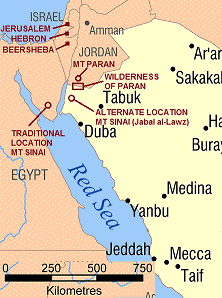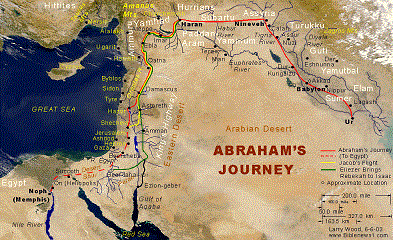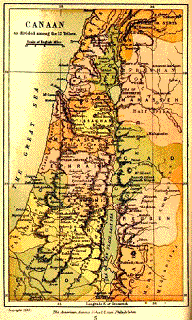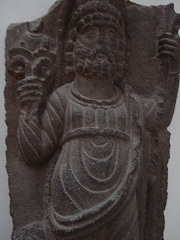Brother Pete | home
Part 1 Part 2
~~~~~~~~~~~~~~~~~~~~~~~
HAJJ & UMRAH
For the PDF tract MECCA, THE KAABA, AND THE BLACK STONE, IN HISTORY, please click here.
The Kaaba in Mecca, Saudi Arabia, is considered by Muslims to be the most sacred and holy place in the world. Islamic tradition suggests it was built by Adam and became the first structure on earth. Muslims believe it was commissioned by Allah in the shape of the House in Heaven called Baitul Ma’amoor around which the angels perform Tawaaf. The structure incorporates a black stone into one corner that is believed to have been sent down by Allah. So important is this site that Muslims from all over the world prostrate themselves toward the Ka'aba, and it's black stone five times a day, when they recite their repetitive prayers to Allah. Muslims are also obligated to travel to Saudi Arabia to perform the "Hajj" at least once in their lifetime as it is the "fifth pillar" of Islam. The Kaaba is believed to be situated at the center of the world with the gate of heaven located directly above it. The dates for the Hajj vary from year to year because the Islamic calendar is a lunar calendar which is about 11 days shorter than the solar calendar. Hajj is conducted on the 7th to the 13th day of the 12th month of the Islamic calendar. The Umra, or small Hajj, may be performed at any time of year.
Since about two million pilgrims showed up in 2009, the affair does not go without incident (including riots and demonstrations), and so even the Saudi Kingdom's website pleads "Be peaceful, orderly and kind. No crushing."
So if "Allah" commissioned the Kaaba to be constructed at the center of the world and below the gate to heaven, 6,000 years ago, why did YHWH ("I AM") give Moses instruction to build a tabernacle on Mount Moriah (God's footstool), that was completed almost 3,000 years ago, that stood a thousand miles from where Mecca was eventually built in the 4th century A.D.?
List of subjects below
Tawaf (circumambulation of the Kaaba 7 times)
Al-Safa & Al-Marwah (running back and forth between 2 hills 7 times)
Ablution (ritual washing) and repetitive prayer
Arafa (crying out loud)
Casting stones (at the devil)
Islamic Tradition
According to the Quran, the Ka'aba was re-built by Abraham and Ishmael, and has presumably been the center of worship for Allah's people, since Adam. However in the 7th century AD the Ka'aba was a center of pagan worship of some 360 rock idols that resided in and around the Ka'aba. Mohammed took issue with the polytheists and eventually recruited forces from neighboring Medina to attack Mecca and force removal of all of the rock idols ..... except the black stone that still resides at the Ka'aba today.
In Islamic tradition Abraham was ordered by Allah to leave Hagar and Ishmael alone in the desert. The story goes that Ishmael was dying of thirst and so Hagar ran frantically back and forth between the hills of Al-Safa and Al-Marwah in search of water. Then Ishmael was supposed to have cried out, and hit the ground with his foot (some variations on that that involve Gabriel), and water sprang forth from the ground. This is how the source of the well that is known as Zamzam is said to have appeared, from which Hagar was able to give Ishmael water.
One of the most obvious difficulties with Mohammed's view is that there is absolutely no record - outside of 7th and 8th century created Islamic tradition - of Abraham, Hagar or Ishmael ever having been in Mecca. According the Scriptural record, confirmed by archaeology, Abraham's travels were mainly in the opposite direction and he never got within a thousand kilometers of Mecca. Indeed the first caravan route along the Red Sea in Saudi Arabia wasn't established until almost a thousand years after Abraham.
An even greater - indeed insurmountable - difficulty is that there is no historical or archaeological record of Mecca ever having existed, prior to the 4th century AD when immigrants from Yemen settled in the area. While there is plenty of such evidence that confirms that Arabian cities like Qedar, Dedan and Teima were established long before, there is no such evidence that Mecca ever existed before the Christian era.
Try a search like - archaeology of mecca - or - historical and archaeological evidence of mecca - or - ancient towns in Arabia. If you can find some evidence that predates the first few centuries AD, that demonstrates that Mecca existed prior to the Christian era, we would appreciate you sharing it with us in the forum. In the absence of such archaeological and historical record, what can be concluded about Mohammed's stand-alone 7th century religion?
While scripture indicates that Abraham did indeed send his wife Sarah's Egyptian handmaiden Hagar, and Hagar's son Ishmael away, and that Ishmael did nearly die of thirst, the first difficulty with the tradition as taught in Islam arises when we consider the geographical location of Abraham's home, and where Hagar and Ishmael wandered, once they were sent out.
(link)
Genesis 21:14 And Abraham rose up early in the morning, and took bread, and a bottle of water, and gave [it] unto Hagar, putting [it] on her shoulder, and the child, and sent her away: and she departed, and wandered in the wilderness of Beersheba. 15 And the water was spent in the bottle, and she cast the child under one of the shrubs.
To suggest that Hagar and Ishmael wandered their way from Beersheba to what eventually became Mecca, would require them to have crossed a thousand kilometers of - at that time - unpopulated, uncharted, unknown, barren, desolate desert, on a single skin of water. The nearest location that anybody has placed Mt. Sinai to Mecca is not within a thousand kilometers across barren desert.
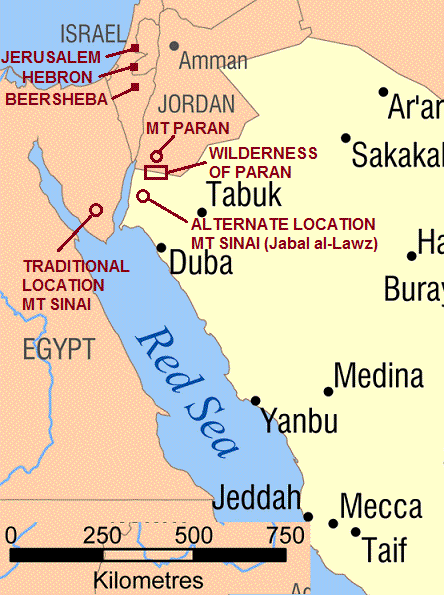
Further, when we consider Abraham's journey, we find it remained largely within the fertile crescent.
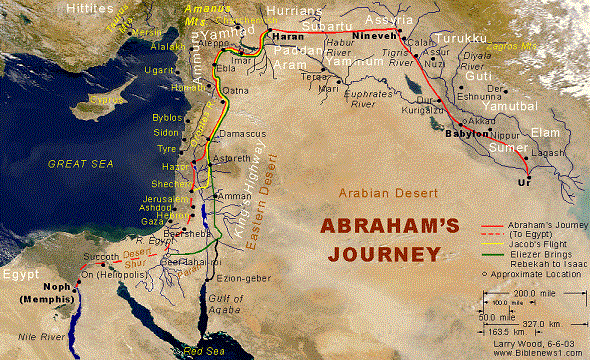
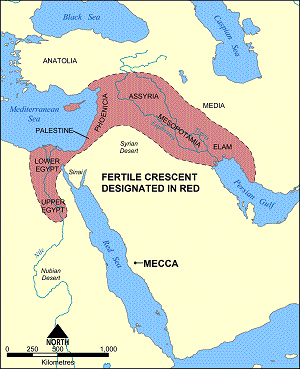
An additional difficulty with the tradition as taught in Islam, is that there is not a single shred of archaeological or historical evidence, that suggests that Mecca ever existed before the 4th century AD when immigrants of the Yemeni tribe of Khuzaa'h settled it, or that the Kaaba existed before it was built by Asa’d Abu Karb in the early 5th century A.D. Please see the "Mecca" page for more on this history.
(link)
So where did the Islamic traditions of the Hajj and Umrah come from?
Much of the following is credited to the 20-year full-time study of Islam accomplished by Dr. Rafat Amari, that is expounded in his book, "Islam: In Light of History". His website is available at the third link on this video.
The Hadith records that pagans controlled the Kaaba before Mohammed started his religion, and that the Kaaba contained 360 idols. After Mohammed returned to Mecca from Medina and broke the "Truce of Hudaybiyyah" he had made with his own tribe the Quraish, he then removed all the idols ..... except one. The black stone that remains to this day is the same that pre-Islamic pagans went on pilgrimage to and circumambulated, in Arabian moon god and Star Family worship.
Making the pilgrimage to that black stone is one of the five pillars of Islam and thus is obligatory for all Muslims to perform at least once in their lifetime. This of course places a severe financial burden on poor Muslims that live in other parts of the world, and even though it's a requirement of Mohammed's religion, millions of Muslims die before they are ever able to afford to travel to Mecca. However from pre-Islamic pagan times unto today, the Hajj has provided a bonanza of imported wealth transferred to Mecca, from elsewhere. So the question arises, would a good God impose such a tremendous physical and financial burden, that falls most heavily on the poorest, and least able, among his followers?
The Hadith indicates that performing the Hajj may provide remission from sin.
Sahih Bukhari Volume 2, Book 26, Number 596:
Narrated Abu Huraira:
The Prophet (p.b.u.h) said, "Whoever performs Hajj for Allah's pleasure and does not have sexual relations with his wife, and does not do evil or sins then he will return (after Hajj free from all sins) as if he were born anew."
So Muslims are taught that walking around the Kaaba seven times, kissing the black stone, traveling from hill to hill near Mecca, casting stones and cutting their hair may provide remission of sin, while at the same time they are taught to reject the shed blood of Jesus Christ that saves everyone from sin - rich or poor - who have faith in His shed blood.
John 3:16 For God so loved the world, that he gave his only begotten Son, that whosoever believeth in him should not perish, but have everlasting life. (more from Dr. Rafat Amari)
(link)
The Kaaba
Sahih Muslim Book 007, Number 3078:
'A'isha (Allah be pleased with her) reported: Allah's Messenger may peace be upon him) said to me: Had your people not been unbelievers in the recent past (had they not quite recently accepted Islam), I would have demolished the Ka'ba and would have rebuilt it on the foundation (laid) by Ibrahim; for when the Quraish had built the Ka'ba, they reduced its (area), and I would also have built (a door) in the rear.
So Mohammed credited the Quraish with building the Kaaba from the ground up. However as mentioned in the "History of Mecca" video the history of Arabia suggests that the Kaaba was built by the leader of the Yemeni tribe of the Khuzaa'h, Abu Karb Asa’d, in the early 5th century AD for Arabian Star Family worship. (more from Dr. Rafat Amari)
The Arabian pagans were civilized enough to respect the areas around their many Kaabas as sanctuary, or safe zones, from fighting. This tradition allowed Muhammad an element of surprise when conveniently "Allah gave permission to His Apostle" to break that sacred tradition:
Bukhari Book #3, Hadith #104: Narrated Said: Abu Shuraih said, "When 'Amr bin Said was sending the troops to Mecca (to fight 'Abdullah bin Az-Zubair) I said to him, 'O chief! Allow me to tell you what the Prophet said on the day following the conquests of Mecca. My ears heard and my heart comprehended, and I saw him with my own eyes, when he said it. He glorified and praised Allah and then said, "Allah and not the people has made Mecca a sanctuary. So anybody who has belief in Allah and the Last Day (i.e. a Muslim) should neither shed blood in it nor cut down its trees. If anybody argues that fighting is allowed in Mecca as Allah's Apostle did fight (in Mecca), tell him that Allah gave permission to His Apostle, but He did not give it to you.
Even in today's times: "A violent clash between Shia pilgrims and demonstrators and the Saudi Arabian security forces during the Hajj pilgrimage, which led to the deaths of over 400 people, occurred in Mecca on 31 July 1987. The event has been variously described as a "riot" or a "massacre." It arose from escalating tensions between Shia Iran and Sunni Saudi Arabia."
(link) 
Tawaf - Circulambulation of the Kaaba and the black stone
Circumambulating Kaabas, venerating stone idols, and going on pilgrimages to religious sites were pagan rituals that preceded Mohammed by centuries, and continue in Mecca unto this day. In performance of Tawaf crowd size permitting, Muslims are to begin by rubbing, or kissing the black stone idol as Muhammad did, or at least point to the stone on each of the seven circuits, one walks around it. The reason they do so, is the same reason they do everything in Islam. Because Muhammad alone, did it, or instructed his followers to do it.
Bukhari B26 #679 Narrated Zaid bin Aslam that his father said: "I saw 'Umar bin Al-Khattab kissing the Black Stone and he then said, (to it) 'Had I not seen Allah's Apostle kissing you, (stone) I would not have kissed you.'"
Besides that bequeathed to us through the actual historical record of Arabia, the Hadith indicates that Muslims went on Hajj right alongside the pagans, until the year before Mohammed's last Hajj, when the pagans were finally expelled from their own ritual.
Sahih Bukhari Volume 2, Book 26, Number 689:
Narrated Abu Huraira:
In the year prior to the last Hajj of the Prophet when Allahs Apostle made Abu Bakr the leader of the pilgrims, the latter (Abu Bakr) sent me in the company of a group of people to make a public announcement: 'No pagan is allowed to perform Hajj after this year, and no naked person is allowed to perform Tawaf of the Kaba.'
Sahih Bukhari Volume 1, Book 8, Number 365:
Narrated Abu Huraira:
On the Day of Nahr (10th of Dhul-Hijja, in the year prior to the last Hajj of the Prophet when Abu Bakr was the leader of the pilgrims in that Hajj) Abu Bakr sent me along with other announcers to Mina to make a public announcement: "No pagan is allowed to perform Hajj after this year and no naked person is allowed to perform the Tawaf around the Ka'ba. Then Allah's Apostle sent 'All to read out the Surat Bara'a (At-Tauba) to the people; so he made the announcement along with us on the day of Nahr in Mina: "No pagan is allowed to perform Hajj after this year and no naked person is allowed to perform the Tawaf around the Ka'ba."
Can you imagine a bunch of naked pagans and Muslims circumambulating the Kaaba? The details of "Tawaf around the Kaaba" are further discussed on the "Mecca" page.
(link)
Al-Safa and Al-Marwah
The ritual of running between Safa and Marwa is called the "Sa'ee". As mentioned earlier Muslims are taught that this ritual has to do with Hagar and Ishmael. Besides the historical and geographical implausibility of that view, the pre-Islamic Umra was a ritual of the Arabian Jinn religion.
In Islam "jinn" are recognized as devils or demons. From Dr. Rafat Amari: "Although the idols were later removed by Islam, the stones where the idols were placed continue to be the subject of Hajj and its worship. Those idols were the two statues of Asaf and Naelah. They were the most venerated priests of Jinn. Two other idols were placed over the two stones, Safa and Marwa. There were also two statues of Asaf and Naelah on these stones." (more from Dr. Rafat Amari)
Arabian mythology claims they committed fornication together inside the Kaabah and the gods transformed them into stone statues. Though the idols were removed by Islam, to this day Muslims still run between Safa and Marwa seven times, just as the pagans did. (more from Dr. Rafat Amari)
Safa and Marwa are two hills close to where Abdel Mutaleb, the grandfather of Mohammed, dug the well of Zamzam and erected the statues of Asaf and Naelah as the deities of the well. (more) As with so many of Mohammed's acquaintances and family members, his grandfather was very much into the Jinn religion and the occult. (more from Dr. Rafat Amari)
Marching around Safa and Marwa, was a ritual hated by some of Mohammed’s companions because they well knew that it was a pagan rite from Jahiliyah, or the pre-Islam period. From the Hadith:
Narrated 'Asim: I asked Anas bin Malik: "Did you use to dislike to perform Tawaf between Safa and Marwa?" He said, "Yes, as it was of the ceremonies of the days of the Pre-lslamic period of ignorance, till Allah revealed: 'Verily! (The two mountains) As-Safa and Al-Marwa are among the symbols of Allah. It is therefore no sin for him who performs the pilgrimage to the Ka'ba, or performs 'Umra, to perform Tawaf between them.' " (2.158) (Sahih al-Bukhari 2 Book 26 710)
Even Ibn Abbas, cousin of Mohammed and Islam's most authoritative reporter, admitted that encompassing Safa and Marwa was the custom of the pagan Arabians before Islam. (more from Dr. Rafat Amari)
Perhaps the reason that Mohammed's "Allah gave a verse" continuing this pagan ritual, is because Mohammed wanted to appease the two lazy bandit tribes of Oas and Khazraj that he enlisted in Medina, who were most into the Jinn religion and whom Mohammed had used to attack his own tribe the Quraish, in the service of his "Allah". Their reward as with all the men that followed Mohammed was, of course, four-fifths of the stolen property, wives, and children of the vanquished, as "spoils of war - booty". That's the title of chapter 8 of the Quran that also details Mohammed's one-fifth share. (more from Dr. Rafat Amari)
The Oas and Khazraj began their Umra Hajj by kissing copies of the statues which were placed on the shore opposite Mecca. They were to walk seven times between these two rocks, then return to Mecca to kiss the two statues of Asaf and Naelah.
(link)
Ritual Cleaning or Ablution
Both the Hajj and Umra begin with ritual cleansing, or ablution, and include repetitive prayer. Muslims pray five times a day, and wash before doing so, because Mohammed told them that is what he learned when he took an overnight trip on a flying animal to Jerusalem, heaven, and back to Mecca by morning.
Far more likely, however, is the fact that Mohammed and at least four of his relatives had been deeply involved in the second century occult cult of the Sabians. This cult had so much impact on Mohammed's daily life that some folks referred to Mohammed as "the Sabian", and Mohammed mentions Sabians right along with Christians, in the Quran. No surprise to discover then, that the Sabians, prayed five times a day and performed ablution.
The source of inspiration for ritual cleansing in Islam is discussed on the "Mohammed's Night Journey" page.
Regarding repetitive prayer, in scripture we are instructed
Matthew 6:7 But when ye pray, use not vain repetitions, as the heathen [do]: for they think that they shall be heard for their much speaking.
Illustrating that being with God is about relationship and not ritual.
(link)
The Cutting of Hair
The cutting of the hair was practiced by some Arabian tribes after a pilgrimage to honor their gods. For example they conducted a pilgrimage to the idol of one of their gods - al-akyaser - where they cut their hair mixed it with flour and tossed it in the air. The same celebration was also observed by many pagan Yemeni tribes. Those same tribes emigrated from Yemen to the area around Medina and Mecca, after the collapse of the dam at Ma'rib in about 150 A.D. Thus cutting hair is still the ritual which ends the Hajj. (more from Dr. Rafat Amari)
Stations of the pre-Islamic Hajj included Arafa, the place where they would stop to worship the sun, and Muzdalifah, where they would stop to worship the moon. Then the Hajj would conclude at Mina, called Muna, the place dedicated to Manat, where they cut their hair and presented their animal sacrifices. This same Hajj was transferred to Islam with the same rituals including the ritual of cutting the hair at Manat. (more from Dr. Rafat Amari)
(link)
Animal Sacrifice
Ibn Hisham, who edited the oldest book on the life of Mohammed, says the statues of Asaf and Naelah were worshipped at the well of Zamzam including the sacrifice of animals to the statues there. This suggests that the well of Zamzam was dedicated, to the worship of the two priests of the Jinn represented by the statues, by Mohammed's grandfather Abdel Mutaleb. This can be concluded first because Abdel Mutaleb dug the well of Zamzam. Second because he worshipped the statues of the two Jinn priests. Indeed Abdel was so consumed by occult worship that he wanted to sacrifice one of his own sons to the two statues at Zamzam. That son was Abdullah, who became the father of Mohammed. When Abdel was close to killing Abdullah with his knife, Abdel's brother stepped in and rescued the boy. (more from Dr. Rafat Amari)
(link)
The Well of Zamzam
Arabians would dig a well for each temple to which they went to sacrifice to the gods they worshipped to build Hajj around the statues of the gods. Among the ceremonies would be drinking water from the well which was dedicated to the deity.
After Abdel Mutaleb dug the well of Zamzam near Safa and Marwa visiting the well and drinking of its water became part of the small Hajj or Umra to honor the deities for which the Hajj was called in the first place, namely the devoted servants of the jinn, Asaf and Naelah. (more from Dr. Rafat Amari)
So dedicated was Abdel Mutaleb to these deities, and so consumed was he by occult worship, that he wanted to sacrifice one of his own sons to the idols of Asaf and Naelah that were placed on Al-Safa and Al-Marwah. That son was Abdullah, the father of Mohammed. When Abdel Mutaleb was at the point of killing Abdullah with his knife, Abdel Mutaleb's brother rescued the boy.[iii][3] (more from Dr. Rafat Amari)
(link)
The Hill of Mina/Muna/Manat
On the second day of Hajj pilgrims depart for the hill Arafa, located east of Mecca. It takes more than four hours to reach this hill by camel. In the middle of the journey to Arafa, there is a place called Muna, currently known as Mina’, where they pray the prayer of noon time. Muna is an important place in the Hajj. Both the words Muna and Manat have the same Arabic meaning, “to wish or aspire.” Manat was the daughter of Allah. This indicates Muna was dedicated to the worship of Manat. (more from Dr. Rafat Amari)
Manat was the deity that Arabians would appeal to when they needed rain. As mentioned in part 2, at the end of their Hajj, they presented animal sacrifices to Manat.
Manat, originally a planet, was represented by a rock on which sacrifices to the various gods were made during the Hajj ceremonies. According to many narrators, this was due to two factors. First, the word Mana means “to shed blood” suggesting to some narrators that the rock of Manat received its name because of all the sacrifices made on the rock of Manat. Second, because Manat means “wish or aspiration,” it was a place where many tribes came to present their animal sacrifices, which represented their own aspirations and pleading for rain. (more from Dr. Rafat Amari)
(link)
“Allah are them, I am here.”
On the third day of Hajj pilgrims continue to the hill called Arafa. They all wear white, indicating a state of consecration, according to tradition. They stand in a plain near a mount called “Jabal Al-Rahmah,” which means the “mountain of mercy,” and cry in loud voices from afternoon until sunset “Labeik Allahumma Labeik.” Allahumma means “Allah, are them,” so their cry is translated, “Allah are them, I am here.”
The same cry was made by Arabians before Manat. They said:
"Allah are them, I am here. Without the prayerful who come early before you, people will fail and abandon you, but they will still come to you in one pilgrimage after another."
When the Hajj was transferred to Islam it presented the same religious words. When the pagans came to the hill dedicated to the worship of the moon they cried “Allah Akber” which means “Allah is greater.” This is because the moon, who was Allah, was viewed as head of the Star Family and was greater than the other members, Ellat, the sun, and Manat and al-'Uzza, two of the planets.
These deities were also mentioned by Mohammed in the Quran.
Sura 53.19 Have ye seen Lat. and 'Uzza, 20 And another, the third (goddess), Manat?
The cry “Allah is greater” is not an Islamic cry but, rather, a pagan cry which the worshippers of the Star Family used to recite. Pre-Islamic Arabian poetry often honored members of the Star Family by emphasizing Allah as the head of the Star Family by repeating the words “Allah Akber." For example, Loas Bin Hagar, the Arabian poet of the pre-Islam period, said:
"I swear by Ellat and al-Uzza and all who follow their faith, and in Allah, Allah is greater than they." (more from Dr. Rafat Amari)
(link)
Casting stones
At Muna, or Mina, the pilgrims cast seven stones at a hill. Islamic tradition claims this locality is where Abraham met with the devil and threw stones at him.
But Satan is a spirit and does not have a material body to be injured by the stones. The Qur’an claims that meteorites were stars which Allah used to strike the devils. However, the casting of stones at the devil was a pagan ceremony practiced by various pagan sects in the Middle East. Casting the stones was a ritual initiated in Muna by the tribe of Sofa who led the ceremonies on the hill of Arafa. The tribe of Sofa did not allow anyone to walk from Arafa to the next Hajj station before all the tribe had thrown stones.
Zoroastrians also cast stones on the water and in bull’s urine, which were prepared for ablutions, and the purification of bodies and objects. Once they were cast, these stones, or pebbles, were deposited in holes in the ground, apparently to strike the insects and worms in the ground which were considered to be devils by the Zoroastrians. (more from Dr. Rafat Amari)
(link)
The Wind Jinn-Devil
The famous Arabian historian and geographer Al-Ya'akubi, of the 9th century, wrote about the life of Arabia before and after Islam. He recorded that another idol placed on the Safa was named Mujawer al-Rih', which in Arabic means “the shelter or place of sanctuary for the wind.” The wind at Mecca was considered as a Jinn-devil. This was recorded by many biographers of Mohammed who mentioned that he was visited by a priest of the Jinn-devils named Thamad al-Azdi who came to embrace Islam. The book of Halabieh recorded:
"The delegation of Thamad al-Azdi who came to Mohammed was reported by Ibn Abbas: 'Thamad came to Mecca and he was from Izd Shina’t, which is the name of his tribe, and he used to cast spells or conjure through the wind which was a devil of Jinn. He greeted Mohammed embracing Islam."
Arabian authors who wrote about Mecca before Islam, like al-Azruqi, mentioned the wind was worshipped at Mecca, and there was an idol there named Nahik who represented the wind that people used to make a pilgrimage to. The idol of the wind, was worshipped as part of a ritual for the worship of the Wind-devil, on the hills of Safa and Marwa. (more from Dr. Rafat Amari)
(link)
Moon god Worship
Since the moon god was considered to be the most powerful deity in Arabian Star Family worship it would seem no coincidence that the Islamic calendar is a lunar calendar. Muslims all over the world bow toward the black stone, that pagans venerated as the moon god idol, five times a day. Crescent moons adorn the tops of mosques and decorate national flags. "Fasting" is done during the month which begins and ends with the appearance of the crescent moon in the sky. Even the favorite shout of Mohammedan suicide murderers - ALLAHU AKBAR - means "Allah is the greatER", which for Arabian moon god worshipers meant that the moon god was the most powerful of all of the Arabian Star Family deities.
A Word to Our Muslim Could-Become Brethren
Will you continue to reject the 1600 year record of God to mankind, as revealed through all of the prophets and witnesses of that record, to instead follow the 23 year 7th century record, of a single "prophet" that had no fulfilled prophecy, that never performed a single miracle, and that not a single person ever heard Gabriel or Allah's voice give a "revelation" to? A man that was a murdering, pillaging, plundering, prisoner raping thief, as revealed through Islam's own books. Would God send a man 500 years after His record was closed, that is revealed as being the exact opposite of Jesus Christ, to present a message that is the exact opposite of the Gospel? A man that led his largely illiterate followers in repackaged rituals of Arabian moon, sun, star, planet and demon worship?
Footnotes
A few of these rituals on YouTube videos appear to the right of the item.
Here's an Umrah Schedule from a tour company:
1. general body cleaning and wudu
2. put on ihram
3. two rakat nafl prayers
4. recite talbiyh
5. Tawaf kabah, 7 circuits (circumambulate Kaaba 7 times kissing, or pointing at, the stone each time) (video)
6. two rakat near maqam i Ibrahim
9. take off ihram
10. umra is complete
11. put on usual dress
(link)
Here's a Hajj schedule from a tour company
I. First day of Hajj (8 Dhul Hijja)
1. after fajr put on ihram (video)
2. go to Mina before zuhr
3. recite talbiya frequently
4. offer zhur, asr, maghrib, isha in Mina
5. overnight stay in Mina
6. first day of hajj is complete
II. Second day of Hajj (9th Dhul Hijjah)
1. second day of hajj, you are in Mina
2. after fajr (sunrise) go to Arafat
3. offer zuhr, asr in Arafat
4. stay in Arafat till sunset do not offer maghrib
5. go to Muzdalifa after sunset
6. offer maghrib, isha at Muzdalifa
7. pick up 49 pebbles or very small stones
8. overnight stay in Muzdalifa
III. Third Day of Hajj (10 Dhul Hijja)
1. third day of hajj you are in Muzdelifa
2. after sunrise go to Mina
3. go to jamaratul Aqaba (last pillar)
4. throw 7 pebbles
5. stop talbiya, say takbir
6. sacrifice animal (they don't seem to get the concept of "sacrifice") (video)
7. clip hair (video)
8. take off ihram
9. put on usual dress
10. go to Mecca
11. perform Tawaf (video)
12. two rakat near Maqama Ibrahim
13. perform Saiy
14. go back to Mina must not stay overnight in Mecca
IV. Fourth Day of Hajj (11 Dhul Hijja)
1. fourth day of hajj you are in Mina
2. after zuhr go to all three jamarat
3. first jamra (jamara tul oola) throw 7 pebbles (video)
4. go to jamra (jamara tul wusta) throw 7 pebbles
5. third jamra (jamara tul aqaba) throw 7 pebbles
6. must stay in Mina
V. Fifth day of Hajj (12 dhul Hijja)
1. fifth day of hajj you are in Mina
2. after zuhr go to all three jamarat
3. first jamra throw 7 pebbles
4. second jamra throw 7 peebles
5. go to third jamra throw 7 peebles
6. after asr go to Mecca
7. perform Tawaf (video)
8. now hajj is complete
9. before leaving Mecca must perform tawaf al wida
